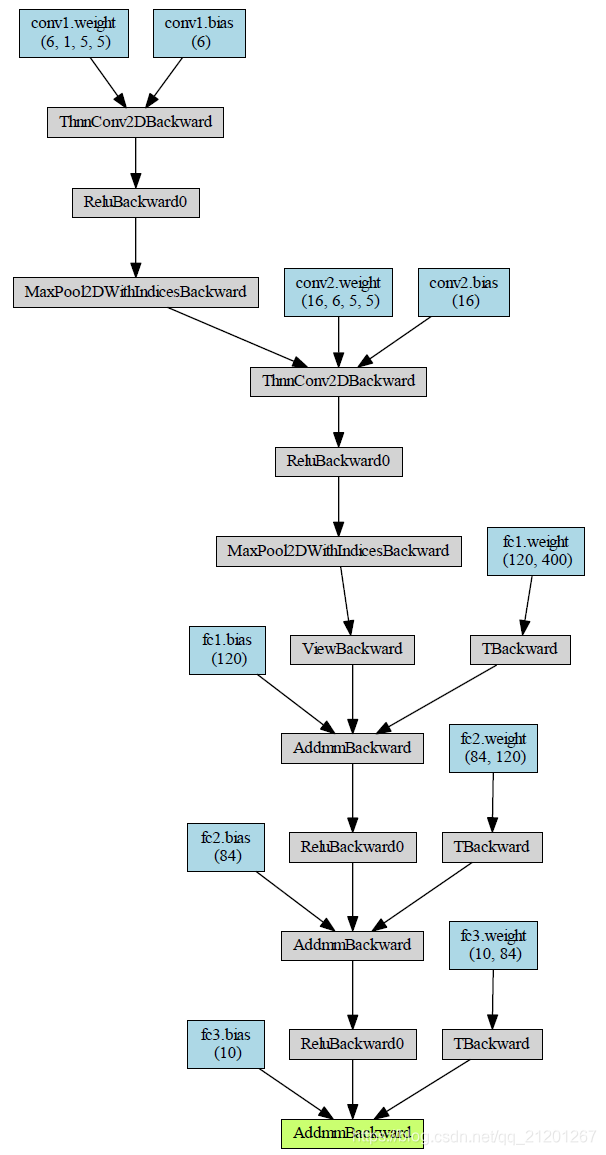文章目录
- 1. 定义模型
- 1.1 绘制模型
- 1.2 模型参数
- 2. 前向传播
- 3. 反向传播
- 4. 计算损失
- 5. 更新参数
- 6. 完整简洁代码
参考 http://pytorch123.com/
1. 定义模型
import torch
import torch.nn as nn
import torch.nn.functional as Fclass Net_model(nn.Module):def __init__(self):super(Net_model, self).__init__()self.conv1 = nn.Conv2d(1,6,5) # 卷积# in_channels, out_channels, kernel_size, stride=1,# padding=0, dilation=1, groups=1,# bias=True, padding_mode='zeros'self.conv2 = nn.Conv2d(6,16,5)self.fc1 = nn.Linear(16*5*5, 120) # FC层self.fc2 = nn.Linear(120, 84)self.fc3 = nn.Linear(84, 10)def forward(self, x):x = self.conv1(x)x = F.relu(x)x = F.max_pool2d(x, (2,2))x = self.conv2(x)x = F.relu(x)x = F.max_pool2d(x, 2)x = x.view(-1, self.num_flat_features(x)) # 展平x = self.fc1(x)x = F.relu(x)x = self.fc2(x)x = F.relu(x)x = self.fc3(x)return xdef num_flat_features(self, x):size = x.size()[1:] # 除了batch 维度外的维度num_features = 1for s in size:num_features *= sreturn num_featuresmodel = Net_model()
print(model)
输出:
Net_model((conv1): Conv2d(1, 6, kernel_size=(5, 5), stride=(1, 1))(conv2): Conv2d(6, 16, kernel_size=(5, 5), stride=(1, 1))(fc1): Linear(in_features=400, out_features=120, bias=True)(fc2): Linear(in_features=120, out_features=84, bias=True)(fc3): Linear(in_features=84, out_features=10, bias=True)
)
1.1 绘制模型
from torchviz import make_dot
vis_graph = make_dot(model(input),params=dict(model.named_parameters()))
vis_graph.view()

1.2 模型参数
params = list(model.parameters())
print(len(params))
for i in range(len(params)):print(params[i].size())
输出:
10
torch.Size([6, 1, 5, 5])
torch.Size([6])
torch.Size([16, 6, 5, 5])
torch.Size([16])
torch.Size([120, 400])
torch.Size([120])
torch.Size([84, 120])
torch.Size([84])
torch.Size([10, 84])
torch.Size([10])
2. 前向传播
input = torch.randn(1,1,32,32)
out = model(input)
print(out)
输出:
tensor([[-0.1100, 0.0273, 0.1260, 0.0713, -0.0744, -0.1442, -0.0068, -0.0965,-0.0601, -0.0463]], grad_fn=<AddmmBackward>)
3. 反向传播
# 清零梯度缓存器
model.zero_grad()
out.backward(torch.randn(1,10)) # 使用随机的梯度反向传播
4. 计算损失
output = model(input)
target = torch.randn(10) # 举例用
target = target.view(1,-1) # 形状匹配 output
criterion = nn.MSELoss() # 定义损失类型
loss = criterion(output, target)
print(loss)
# tensor(0.5048, grad_fn=<MseLossBackward>)
- 测试
.zero_grad()清零梯度缓存作用
model.zero_grad()
print(model.conv1.bias.grad)
loss.backward()
print(model.conv1.bias.grad)
输出:
tensor([0., 0., 0., 0., 0., 0.])
tensor([-0.0067, 0.0114, 0.0033, -0.0013, 0.0076, 0.0010])
5. 更新参数
learning_rate = 0.01
for f in model.parameters():f.data.sub_(f.grad.data*learning_rate)
6. 完整简洁代码
criterion = nn.MSELoss() # 定义损失类型
import torch.optim as optim
optimizer = optim.SGD(model.parameters(), lr=0.1)# 优化目标,学习率# 循环执行以下内容 训练
optimizer.zero_grad() # 清空梯度缓存
output = model(input) # 输入,输出,前向传播loss = criterion(output, target) # 计算损失loss.backward() # 反向传播optimizer.step() # 更新参数


)


)

)


)



)



)
